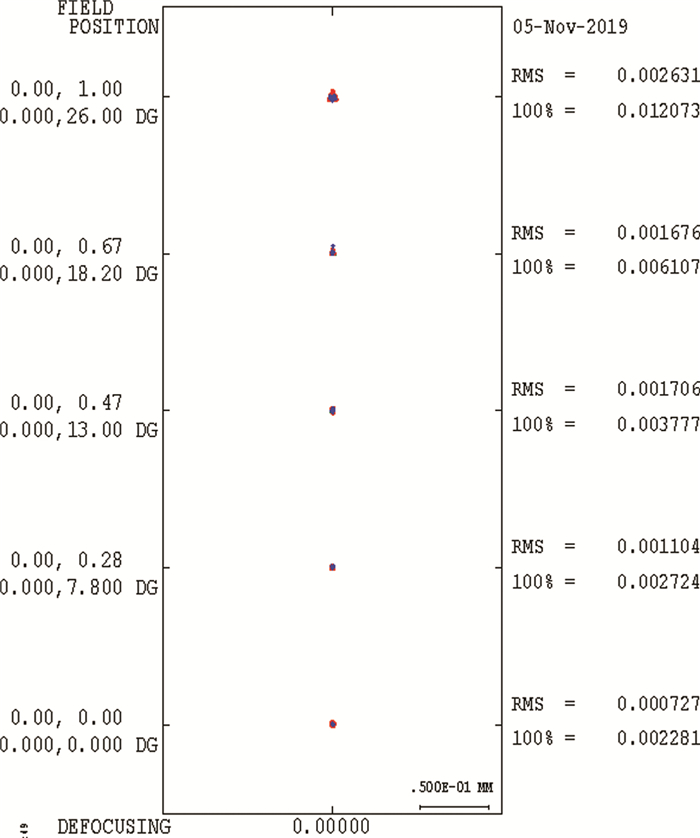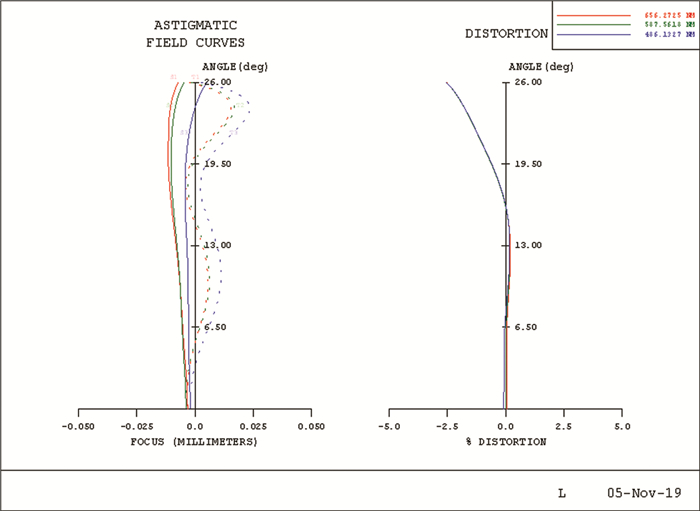HTML
-
2000年,日本的夏普和J-PHONE联合推出了世界上第一款具有拍照功能的手机J-SHO4手机,其像素为11万,照片的最大分辨率为355×288。2003年,索尼爱立信研发了具有拍照功能的手机T618,其像素为10万,该款手机是进入国内的第一款具有拍照功能的手机[1-2]。国外有一些具有拍照功能的手机生产厂商,如苹果、三星、索尼;而国内涌现出许多具有拍照功能的手机生产厂商,如华为、小米、OPPO、魅族等,手机镜头设计得到越来越多研究人员的青睐[3-18]。与数码相机相比,手机镜头具有更便携带且可以实时共享等优点,越来越得到大众的青睐。手机镜头从最初的几十万像素到现在的几千万像素,基本已经取代了一些低端的数码相机。手机镜头在满足高像素的同时,还希望向着大相对孔径、大视场、轻小型化、结构简单紧凑方向发展。
感光器件有电荷耦合器件(charge-coupled device,CCD)和互补金属氧化物半导体(complementary metal oxide semiconductor,CMOS)器件两种[19],CCD通常用于高端数码相机,由于CMOS器件具有价格低、功耗低、体积小、读取速度快等优点,因此CMOS器件通常用于手机镜头。
随着生产工艺的不断进步,CMOS器件像元越来越小,手机镜头的分辨率越来越高。目前文献中报道的手机镜头的像素都不太高,大多为800万像素,相对孔径也不太大,且大多含有衍射光学元件,可加工性不太好。本文中报道了一种1600万像素大相对孔径高分辨率手机镜头,给出了具体的设计结果,其结构简单,采用5片非球面塑料透镜,焦距为3.85mm, 相对孔径为1/2.2,CMOS器件像元尺寸为1.44μm,取得了良好的成像质量,空间频率350lp/mm处,所有视场的调制传递函数(modulation transfer function,MTF)均优于0.2,0.7视场内的MTF均优于0.34,全视场内的场曲小于0.02mm,畸变小于2.55%。
-
手机镜头的工作原理是光线经过手机透镜组成像在CCD或CMOS器件上,CCD或CMOS将光信号转换为电信号,通光模拟转换器件将模拟信号转换为数字信号,图像处理器将数字图像信号压缩后经过处理存储在存储器上。
镜头初始结构的建立对于镜头设计至关重要。好的初始结构可以很快优化得到满足设计要求的结果,不合适的初始结构可能无论怎么优化也难以取得满足设计结果的结构。目前主要有两种获取初始结构的方法,一种是设计人员根据设计要求按照近轴光学原理计算得到薄透镜下的光学元件参量,而后结合光学设计软件进行优化设计,最终得到满足设计要求的结果;另一种是通过查找专利文件作为起始结构而后再优化设计。本文中涉及的大相对孔径高分辨率手机镜头方面,类似的镜头专利不多,有的仅给出了光路图,没有给出具体的光学元件参量。作者提出了一种根据透镜的材料特性,并结合设计师经验来确定系统的初始结构方法,选取E48R和LEXANH两种塑料,根据其色散系数的特点,用E48R塑料作正透镜,LEXANH塑料作负透镜,得到了一种初始结构为正-负-负-正-负的初始结构,可以通过逐步增大口径,增大视场,增大相对孔径的方法,进行不断的人工干预修改,保证透镜中心厚度和边缘厚度有一定的厚度,避免透镜厚度太薄不好加工,避免边缘厚度太薄加工时破碎,保证透镜之间有一定的空气间隔,避免透镜相碰,最终得到满意的结构。
-
大相对孔径高分辨率手机镜头的主要技术指标如表 1所示。
focal length 3.85mm field of view 52° F# 2.2 back working distance 0.5mm maximum incident angle < 30° distortion < 3% total length < 5.2mm working waveband 486nm~656nm MTF 350lp/mm@0.15 Table 1. Targets of design specifications for lens
手机镜头的光学材料可以为玻璃和塑料,手机镜头相对孔径越大,CMOS器件像素越小,光学像差校正难度越大,使用非球面可以较好地校正手机镜头的各自像差,减少光学元件的数量,而玻璃上制作非球面的成本较高,塑料可以注塑加工成型,因此, 本文中设计的手机镜头中全部采用塑料非球面。
考虑到实际光学加工的要求,透镜的中心厚度和边缘厚度不能太薄,实际优化时设定透镜的中心厚度都大于0.5mm,透镜的边缘厚度都大于0.3mm,以透镜的曲率半径、透镜厚度、空气间隔、二次曲面系数、非球面系数作为变量进行不断迭代,必要时进行人工干预修改。优化后的大相对孔径高分辨率手机镜头光路图如图 1所示。第1片和第4片透镜采用E48R的塑料材质,E48R塑料材质的折射率和阿贝数分别是1.53和56.04;第2片、第3片和第5片透镜采用LEXANH的塑料材质,LEXANH塑料材质的折射率和阿贝数分别是1.58和30.29;滤光片为厚度为0.3mm,材料采用成都光明的HK9光学玻璃,滤光片可以滤除来自物体的红外光;保护玻璃为厚度为0.4mm的HK9光学玻璃(成都光明),保护玻璃可以对CMOS器件起到保护作用。从第1面到像面的距离为5.05mm,后焦距为0.5mm,主光线在像面上的最大入射角度为23.8°,满足CMOS器件入射角度的要求。
图 2为大相对孔径高分辨率手机镜头的光线像差曲线。横坐标代表位置,纵坐标代表像差的大小,可以从横向特性像差曲线图中得到不同视场、不同波长下的像差大小,以及差值的最大范围。横向特性像差曲线的纵坐标越小,说明像差校正的越好。由图可知,大相对孔径、高分辨率手机镜头的光线像差曲线比较平滑,纵坐标最大值小于0.012,大相对孔径、高分辨率手机镜头的光线像差得到了较好的校正。
点列图表征不同波长,不同视场下的艾里斑直径大小和弥散斑的均方根直径大小,不同的颜色表示不同的波长,不同的图形代表不同的视场。点列图中的弥散斑越小,系统的成像质量越好。当均方根弥散斑直径在艾里斑很小的邻域内时,系统符合成像要求。图 3为设计的手机镜头的点列图。可知各个视场的弥散斑都较小,0.7视场内的最大均方根弥散斑直径为1.68μm,1视场内的最大均方根弥散斑直径为2.63μm。
MTF曲线用来评估不同空间频率时,物体经过光学系统成像后的解析度百分比[20]。MTF曲线中横坐标表示空间频率,纵坐标表示像和物的对比度比值,系统的MTF曲线越高,像的对比度越逼近物的对比度,系统的成像性能越好,不同的曲线表示不同视场的MTF性能。CMOS器件的像元尺寸为1.44μm,计算可知该CMOS器件的截止频率为347lp/mm,取该手机镜头的空间频率为350lp/mm。图 4是手机镜头的MTF曲线。可知空间频率350lp/mm处,所有视场的MTF均大于0.2,0.7视场内的MTF均大于0.34,满足设计要求。
光线经过光学系统后,形成的光学图像不再和光轴垂直,而是在以光轴为对称轴的弯曲曲面上,该弯曲曲面为光学系统的最佳理想像面,光学系统的这种成像误差为场曲。由于轴外点主光线在像面上交点的位置和理想像的位置不重合,存在一定的高度偏差,这种高度偏差称为畸变,因此畸变是一种轴外像差。光学系统存在畸变时,得到的图像清晰度不会发生变化,系统的分辨率有所降低,物体的大小和形状会发生变化。图 5为大相对孔径高分辨率手机镜头的场曲和畸变曲线。可知该镜头的全视场内的场曲小于0.02mm,最大畸变为2.55%,满足设计要求。
-
通过选取合适的初始光学结构,借助塑料非球面应用光学设计软件Code-v设计了一款大相对孔径高分辨率的手机镜头。该手机镜头焦距为3.85mm,相对孔径为1/2.2,工作波段为486nm~656nm,视场角为52°,由5片非球面塑料透镜、1片红外滤波片、1片保护玻璃组成: 第1片和第4片透镜为正透镜,第2片、第3片和第5片透镜为负透镜,采用了E48R和LEXANH两种非球面塑料透镜。主光线在像面上的最大入射角度为23.8°,满足CMOS器件入射角度的要求,在空间频率350lp/mm处,所有视场的MTF均优于0.2,0.7视场内的MTF均优于0.34,全视场内的场曲小于0.02mm,畸变小于2.55%,具有结构紧凑、质量轻、成本低、成像质量好等优点。

 Map
Map


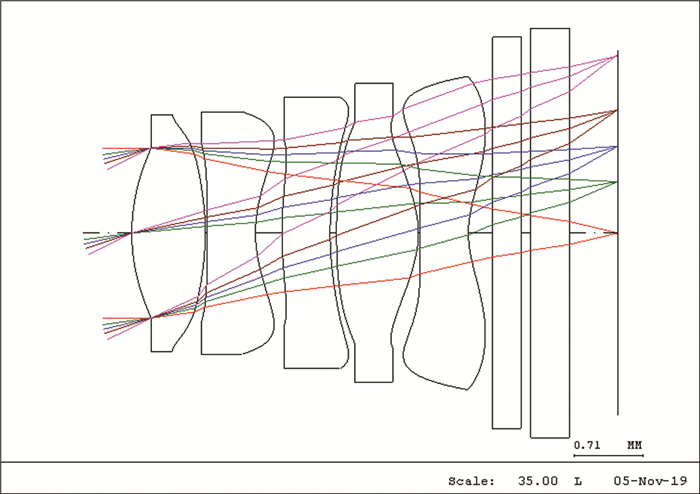

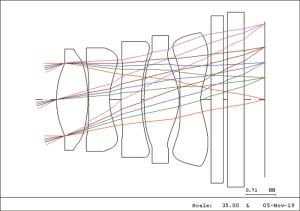
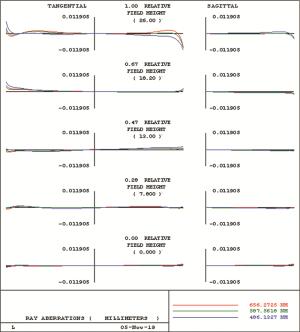
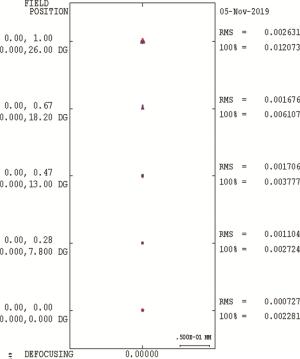
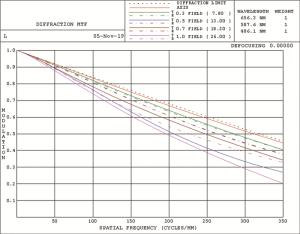
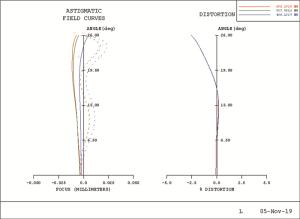
 DownLoad:
DownLoad:

